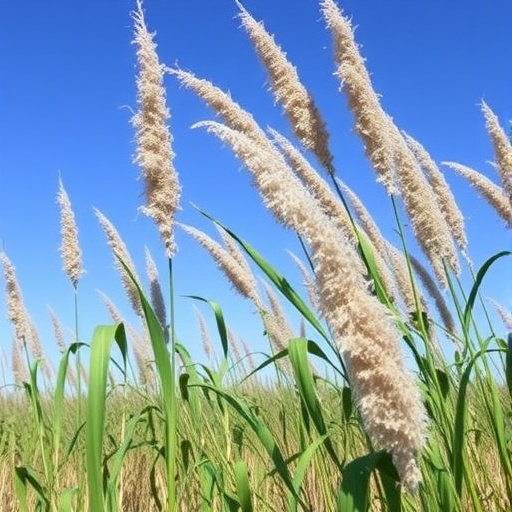In a groundbreaking study published in “Waste Biomass Valor,” researchers, led by Al-Iraqi et al., delve into the fascinating realm of biogas production derived from the anaerobic digestion of Phragmites australis, commonly known as common reed. This research sheds light on several critical factors that can significantly influence biogas yield, including the grinding process, the harvesting season, and the co-digestion with food waste. These insights contribute to a greater understanding of organic waste utilization, paving the way for innovative solutions in the realm of renewable energy.
The anaerobic digestion process stands at the forefront of waste-to-energy technologies. In this method, microorganisms decompose organic material in the absence of oxygen, resulting in the production of biogas, primarily composed of methane and carbon dioxide. The study captures the essence of how optimizing conditions and inputs can lead to enhanced biogas production, thereby highlighting the potential of Phragmites australis as an exemplary biomass feedstock. Traditionally seen as a weed in many ecosystems, Phragmites australis now emerges as a potential hero in the quest for renewable energy resources.
A crucial aspect of the study is the examination of the grinding process. Researchers found that the mechanical preprocessing of Phragmites australis could significantly enhance the surface area available for microbial attack. This increase in surface area accelerates the digestion process, resulting in a higher yield of biogas. By employing various grinding techniques, the study meticulously compares the efficiency of each method, drawing correlations between the degree of grinding and the extent of biogas production.
The harvesting season also plays an integral role in this intricate biochemical process. The study reveals that the nutritional composition and moisture content of Phragmites australis vary throughout the year, influencing its digestibility and biogas potential. By analyzing samples harvested in different seasons, the researchers discover optimal harvesting windows that maximize both biomass availability and biogas yield. Such insights underline the importance of timing in biomass utilization, emphasizing that careful management of harvesting practices can lead to substantial increases in energy recovery.
Co-digestion with food waste represents another focal point of the study, showcasing the synergistic effects that can arise when combining different organic materials. The research demonstrates that introducing food waste into the anaerobic digestion process alongside Phragmites australis creates a more balanced nutrient profile. This balance fosters a more conducive environment for microbial communities, ultimately leading to improved biogas production. Such findings advocate for an integrated approach to waste management that not only addresses food waste but also makes use of readily available biomass resources like common reed.
Sustainability remains a cornerstone of the research. In an era where the search for renewable energy sources is paramount, the utilization of biomass, particularly that of invasive species like Phragmites australis, promotes ecological management while simultaneously generating energy. Researchers emphasize that the dual benefits of ecological restoration and energy generation can be achieved through careful management of these invasive plant species, making this study particularly timely considering the environmental challenges we face.
The implications of this research extend beyond the laboratory. Policymakers and environmental advocates can draw upon these findings to bolster initiatives aimed at promoting renewable energy sources and managing organic waste. Communities can invest in local anaerobic digestion facilities that utilize Phragmites australis and food waste, enhancing energy self-sufficiency while addressing pressing waste management challenges. This aligns with global efforts to transition towards circular economies, where waste materials are seen as valuable resources rather than mere refuse.
As more municipalities recognize the potential of anaerobic digestion, they may find Phragmites australis to be an abundant, underutilized resource. Widespread adoption of such practices could herald a new era of sustainable energy production, where biomass from invasive species is harnessed to meet growing energy demands. The research highlights not only the feasibility but also the practicality of integrating agricultural practices with waste management and renewable energy production.
Furthermore, the study catalyzes further research opportunities. As we continue to grapple with environmental issues such as climate change and resource depletion, understanding the biochemistry of anaerobic digestion will be critical. Future studies can explore the genetic and biochemical pathways of the microbial communities responsible for the digestion process in different organic substrates. Uncovering these pathways could lead to the development of bioengineered microorganisms tailored for specific feedstocks, driving efficiencies in biogas production even further.
In conclusion, the work of Al-Iraqi and colleagues presents a compelling case for the utilization of Phragmites australis in biogas production, demonstrating how scientific inquiry can unlock the potential of common yet overlooked resources. As society pushes towards greener practices and sustainable energy solutions, this research stands as a beacon of hope, offering actionable insights for communities, industry stakeholders, and environmentalists alike.
The study not only enriches the scientific discourse surrounding renewable energy but also serves as a pivotal reminder that innovation can often emerge from the most unexpected sources. By championing the potential of Phragmites australis and advocating for integrated waste management solutions, we may be one step closer to a more sustainable future powered by renewable energy.
Subject of Research: Biogas Production from Anaerobic Digestion of Phragmites australis
Article Title: Biogas Production from Anaerobic Digestion of Phragmites australis: Influence of Grinding Process, Harvesting Season and Co-digestion with Food Waste.
Article References:
Al-Iraqi, A.R., Gandhi, B.P., Folkard, A.M. et al. Biogas Production from Anaerobic Digestion of Phragmites australis: Influence of Grinding Process, Harvesting Season and Co-digestion with Food Waste.
Waste Biomass Valor (2025). https://doi.org/10.1007/s12649-025-03293-1
Image Credits: AI Generated
DOI:
Keywords: Biogas, Anaerobic Digestion, Phragmites australis, Co-digestion, Renewable Energy, Waste Management, Food Waste, Invasive Species.




